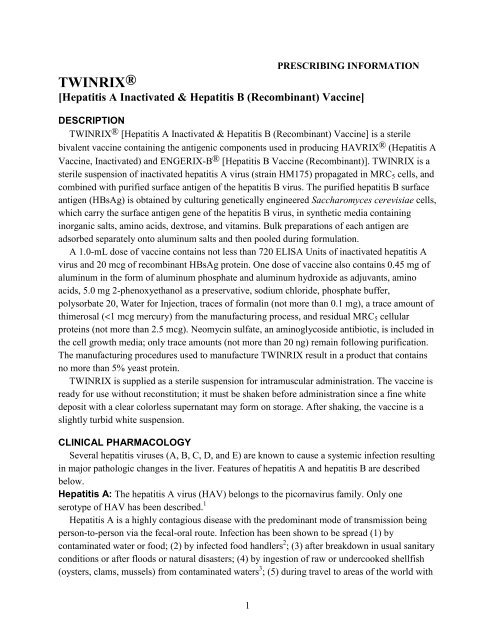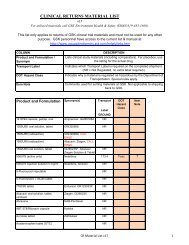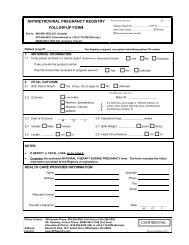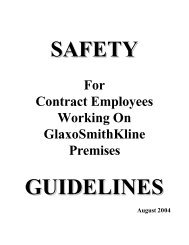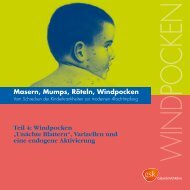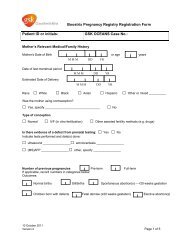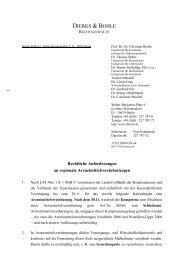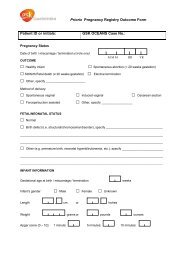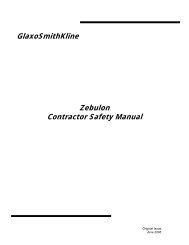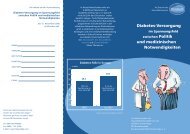twinrix - GlaxoSmithKline Pregnancy Registries
twinrix - GlaxoSmithKline Pregnancy Registries
twinrix - GlaxoSmithKline Pregnancy Registries
Create successful ePaper yourself
Turn your PDF publications into a flip-book with our unique Google optimized e-Paper software.
poor hygienic conditions 4 ; (6) among institutionalized children and adults 5 ; (7) in day-carecenters 6 ; and (8) by parenteral transmission, either blood transfusions or sharing needles withinfected people. 7In the United States, attack rates for hepatitis A disease are cyclical and vary by population.The rates have increased gradually from 10.4 per 100,000 in 1987 to 11.7 per 100,000 in 1996. 8The incubation period for hepatitis A averages 28 days (range: 15 to 50 days). 9 The course ofhepatitis A infection is extremely variable, ranging from asymptomatic infection to icterichepatitis. However, most adults (76% to 97%) become symptomatic. 10 Symptoms range frommild and transient to severe and prolonged, and may include fever, nausea, vomiting, anddiarrhea in the prodromal phase, followed by jaundice in up to 88% of adults, as well ashepatomegaly and biochemical evidence of hepatocellular damage. 10 Recovery is generallycomplete and followed by protection against HAV infection. However, illness may be prolonged,and relapse of clinical illness and viral shedding have been described. 11 Up to 22% of adults whocontract hepatitis A are hospitalized and approximately 100 patients die annually in the UnitedStates from complications of hepatitis A. 12Chronic shedding of HAV in feces has not been demonstrated, but relapses of hepatitis A canoccur in as many as 20% of patients 11,13 and fecal shedding of HAV may recur at this time. 11Approximately 70% of pediatric patients less than 6 years of age infected with hepatitis A areasymptomatic, and serve as a reservoir for infection among adults. 12The presence of antibodies to HAV, as detected in a standardized assay (HAVAB), is anindication of the presence of protective antibodies against hepatitis A disease. Natural infectionprovides lifelong immunity even when antibodies to hepatitis A are undetectable. At present,studies show the duration of protection afforded by TWINRIX against hepatitis A lasts at least4 years. 14Hepatitis B: The hepatitis B virus (HBV) belongs to a family of genetically relatedDNA-containing animal viruses, which are hepatotropic. The incubation period of hepatitis Branges between 30 and 180 days. The mode of transmission of hepatitis B may be: By contact(contaminated body secretions including semen, vaginal secretions, blood, saliva);percutaneously (usually through accidental needlesticks or by sharing needles with infectedpeople); or by maternal-neonatal transmission. 15HBV infection occurs throughout the world with highly variable prevalences. A humanreservoir of persistently infected persons is present in nearly all communities of the world. In theUnited States, parenteral drug abuse, unprotected sexual activity, occupationally acquiredinfection, or travelers returning from high prevalence countries may be the principal mechanismsof HBV transmission.Clinical infection with hepatitis B may occur in 2 major forms: Asymptomatic or symptomatichepatitis. Asymptomatic HBV infection can be subclinical or inapparent. In subclinical infection,patients have abnormal liver enzymes without jaundice, while inapparent asymptomatic infectionis identified only by serological testing. One in 4 adults who has symptomatic disease hasjaundice (anicteric/icteric hepatitis).2
HBV infection can have serious consequences including acute massive hepatic necrosis,chronic active hepatitis, and cirrhosis of the liver. As many as 90% of infants and 6% to 10% ofadults who are infected in the United States will become HBV carriers. 12 An estimated 200 to300 million people are chronic carriers of HBV worldwide. 12 The Centers for Disease Controland Prevention (CDC) estimates that there are approximately 1 million to 1.25 million chroniccarriers of HBV in the United States. 12 About 50,000 cases of hepatitis are reported per year,about half of which are hepatitis B. Unreported cases may be 10 times greater. Close contact(sexual contact or household contact) or exposure to blood from infected individuals isassociated with increased risk of infection. Those patients who become chronic carriers caninfect others and are at increased risk of developing primary hepatocellular carcinoma. Amongother factors, infection with HBV may be the single most important factor for development ofthis carcinoma. 12,16Reduced Risk of Hepatocellular Carcinoma: A clear link has been demonstrated betweenchronic HBV infection and the occurrence of hepatocellular carcinoma. In a Taiwanese study,the institution of universal childhood immunization against HBV has been shown to decrease theincidence of hepatocellular carcinoma among children. 17 In a Korean study in adult males,vaccination against HBV has been shown to decrease the incidence of, and risk of, developinghepatocellular carcinoma in adults. 18There is no definitive treatment for acute HBV infection. However, those who developantibodies to HBsAg after active infection are protected against subsequent infection. Antibodytiters ≥10 mIU/mL against HBsAg are recognized as conferring protection against HBV. 19Seroconversion is defined as an antibody titer ≥1 mIU/mL.Clinical Trials: Immunogenicity in Adults: Sera from 1,551 healthy adult volunteers ages17 to 70, including 555 male subjects and 996 female subjects, in 11 clinical trials were analyzedfollowing administration of 3 doses of TWINRIX on a 0-, 1-, and 6-month schedule.Seroconversion for antibodies against HAV was elicited in 99.9% of vaccinees, and protectiveantibodies against HBV were detected in 98.5%, 1 month after completion of the 3-dose series.Table 1. Immunogenicity in TWINRIX Worldwide Clinical TrialsTWINRIX Dose N% Seroconversionfor Hepatitis A *1158793.82157198.83155199.9* Anti-HAV titer ≥assay cut-off: 20 mIU/mL (HAVAB Test) or 33 mIU/mL(ENZYMUN-TEST ® ).† Anti-HBsAg titer ≥10 mIU/mL (AUSAB ® ).% Seroprotectionfor Hepatitis B †30.878.298.5One of the 11 trials was a comparative trial conducted in a US population given eitherTWINRIX (on a 0-, 1-, and 6-month schedule) or HAVRIX (0- and 6-month schedule) andENGERIX-B (0-, 1-, and 6-month schedule). The monovalent vaccines were given concurrently3
in opposite arms. Of a total of 773 adults (ages 18 to 70 years) enrolled in this trial, animmunogenicity analysis was performed in 533 subjects who completed the study according toprotocol. Of these, 264 subjects received TWINRIX and 269 subjects received HAVRIX andENGERIX-B. Seroconversion against HAV and seroprotection against HBV are shown in Table2.Table 2. Percentage of Seroconversion or Seroprotection Rates in the TWINRIX USClinical TrialVaccine N TimepointTWINRIX 264 Month 1Month 2Month 7HAVRIX and 269 Month 1ENGERIX-BMonth 2Month 7% Seroconversionfor Hepatitis A *(95% CI)91.697.799.6 (97.9-100.0)98.198.999.3 (97.3-99.9)* Anti-HAV titer ≥assay cut-off: 33 mIU/mL (ENZYMUN-TEST ® ).† Anti-HBsAg titer ≥10 mIU/mL (AUSAB ® ).% Seroprotectionfor Hepatitis B †(95% CI)17.961.295.1 (91.7-97.4)7.550.492.2 (88.3-95.1)Since the immune responses to hepatitis A and hepatitis B induced by TWINRIX werenon-inferior to the monovalent vaccines, efficacy is expected to be similar to the efficacy foreach of the monovalent vaccines (Table 3).Table 3. Geometric Mean Titers in the TWINRIX US Clinical TrialVaccine N TimepointGMT to Hepatitis A(95% CI)GMT to Hepatitis B(95% CI)TWINRIX 263259264HAVRIX andENGERIX-B268269269Month 1Month 2Month 7Month 1Month 2Month 73356364756 (4152-5448)4442572948 (2638-3294)8232099 (1663-2649)6181871 (1428-2450)It was noted that the antibody titers achieved 1 month after the final dose of TWINRIX werehigher than titers achieved 1 month after the final dose of HAVRIX in these clinical trials. Thismay have been due to a difference in the recommended dosage regimens for these 2 vaccines,whereby TWINRIX vaccinees received 3 doses of 720 EL.U. of hepatitis A antigen at 0, 1, and6 months, whereas HAVRIX vaccinees received 2 doses of 1440 EL.U. of the same antigen (at 0and 6 months). However, these differences in peak titer have not been shown to be clinicallysignificant.4
Two clinical trials involving a total of 129 subjects demonstrated that antibodies to both HAVand HBV persisted for at least 4 years after the first vaccine dose in a 3-dose series ofTWINRIX, given on a 0-, 1-, and 6-month schedule. For comparison, after the recommendedimmunization regimens for HAVRIX and ENGERIX-B, respectively, similar studies involving atotal of 114 subjects have shown that seropositivity to HAV and HBV also persists for at least4 years.The effect of age on immune response to TWINRIX was studied in 2 trials comparingsubjects over 40 years of age (n = 183, mean age = 48 in one trial and n = 72, mean age = 50 inthe other) with those ≤40 (n = 191; mean age 32.5). The response to the hepatitis A componentof TWINRIX declined slightly with age, but >99% of subjects achieved protective antibodylevels in both age groups, and antibody titers were comparable to 2 doses of hepatitis A vaccinealone in age matched controls.The response to hepatitis B immunization is known to decline in vaccinees over 40 years ofage. TWINRIX elicited a seroprotective response to hepatitis B in 97% of younger subjects and93% to 94% of the older subjects, as compared to 92% of older subjects given hepatitis Bvaccine alone. Geometric mean titers elicited by TWINRIX were 2,285 in the younger subjectsand 1,890 or 1,038 for the older subjects in the 2 trials. Hepatitis B vaccine alone gave titers of2,896 in younger subjects and 1,157 in those over 40 years of age.It has been shown in open randomized clinical trials that combining the hepatitis A antigenwith the hepatitis B surface antigen in TWINRIX resulted in comparable anti-HAV oranti-HBsAg titers, relative to vaccination with the individual monovalent vaccines or theconcomitant administration of each vaccine in opposite arms.Immune Response to Simultaneously Administered Vaccines: There have been nostudies of concomitant administration of TWINRIX with other vaccines.INDICATIONS AND USAGETWINRIX is indicated for active immunization of persons 18 years of age or older againstdisease caused by hepatitis A virus and infection by all known subtypes of hepatitis B virus. Aswith any vaccine, vaccination with TWINRIX may not protect 100% of recipients. Ashepatitis D (caused by the delta virus) does not occur in the absence of HBV infection, it can beexpected that hepatitis D will also be prevented by vaccination with TWINRIX.TWINRIX will not prevent hepatitis caused by other agents such as hepatitis C virus,hepatitis E virus, or other pathogens known to infect the liver.Immunization is recommended for all susceptible persons 18 years of age or older who are, orwill be, at risk of exposure to both hepatitis A and hepatitis B viruses, including but not limitedto:• Travelers: Persons traveling to areas of high/intermediate endemicity for both HAV and HBV(see Table 4) who are at increased risk of HBV infection due to behavioral or occupationalfactors. (See CLINICAL PHARMACOLOGY.)5
Table 4. Hepatitis A and Hepatitis B Endemicity by RegionGeographic Region HAV HBVAfrica High High (most)Caribbean High IntermediateCentral America High IntermediateSouth America (temperate) High IntermediateSouth America (tropical) High HighSouth and Southeast Asia * High HighMiddle East † High HighEastern Europe Intermediate IntermediateSouthern Europe Intermediate IntermediateFormer Soviet Union Intermediate Intermediate* Japan: Low HAV and intermediate HBV endemicity.† Israel: Intermediate HBV endemicity.• Patients With Chronic Liver Disease, including:– alcoholic cirrhosis– chronic hepatitis C– autoimmune hepatitis– primary biliary cirrhosis• Persons at Risk Through Their Work:– Laboratory workers who handle live hepatitis A and hepatitis B virus– Police and other personnel who render first-aid or medical assistance– Workers who come in contact with feces or sewage• Others:– Healthcare personnel who render first-aid or emergency medical assistance.– Personnel employed in day-care centers and correctional facilities. Residents of drug andalcohol treatment centers. Staff of hemodialysis units.– People living in, or relocating to, areas of high/intermediate endemicity of HAV and whohave risk factors for HBV.– Men who have sex with men.20, 21– Persons at increased risk of disease due to their sexual practices.– Patients frequently receiving blood products including persons who have clotting factordisorders (hemophiliacs and other recipients of therapeutic blood products).– Military recruits and other military personnel at increased risk for HBV.– Users of injectable illicit drugs.– Individuals who are at increased risk for HBV infection and who are close householdcontacts of patients with acute or relapsing hepatitis A and individuals who are at increasedrisk for HAV infection and who are close household contacts of individuals with acute orchronic hepatitis B infection.6
CONTRAINDICATIONSHypersensitivity to any component of the vaccine, including yeast and neomycin, is acontraindication (see DESCRIPTION). This vaccine is contraindicated in patients with previoushypersensitivity to TWINRIX or monovalent hepatitis A or hepatitis B vaccines.WARNINGSThere have been rare reports of anaphylaxis/anaphylactoid reactions following routine clinicaluse of TWINRIX. (See CONTRAINDICATIONS.)The vial stopper is latex-free. The tip cap and the rubber plunger of the needleless prefilledsyringes contain dry natural latex rubber that may cause allergic reactions in latex sensitiveindividuals.Hepatitis A and hepatitis B have relatively long incubation periods. The vaccine may notprevent hepatitis A or hepatitis B infection in individuals who have an unrecognized hepatitis Aor hepatitis B infection at the time of vaccination. Additionally, it may not prevent infection inindividuals who do not achieve protective antibody titers.PRECAUTIONSGeneral: As with other vaccines, although a moderate or severe acute illness is sufficient reasonto postpone vaccination, minor illnesses such as mild upper respiratory infections with or withoutlow-grade fever are not contraindications. 22Multiple Sclerosis: Results from 2 clinical studies indicate that there is no associationbetween hepatitis B vaccination and the development of multiple sclerosis, 23 and that vaccinationwith hepatitis B vaccine does not appear to increase the short-term risk of relapse in multiplesclerosis. 24TWINRIX should be administered with caution to people on anticoagulants, and those withthrombocytopenia or a bleeding disorder since bleeding may occur following intramuscularadministration to these subjects.As with any vaccine, if administered to immunosuppressed persons or persons receivingimmunosuppressive therapy, the expected immune response may not be obtained. 25Before the injection of any vaccine, the physician should take all reasonable precautions toprevent allergic or other adverse reactions, including understanding the use of the vaccineconcerned, and the nature of the side effects and adverse reactions that may follow its use.Prior to immunization with any vaccine, the patient’s history should be reviewed. Thephysician should review the patient’s immunization history for possible vaccine sensitivity,previous vaccination-related adverse reactions, and occurrence of any adverse event–relatedsymptoms and/or signs in order to determine the existence of any contraindication toimmunization with TWINRIX and to allow an assessment of benefits and risks. As with anyparenteral vaccine, epinephrine injection (1:1,000) and other appropriate agents used for thecontrol of immediate allergic reactions must be immediately available should an acuteanaphylactic reaction occur.7
A separate sterile syringe and needle or a sterile disposable unit must be used for each patientto prevent the transmission of infectious agents from person to person. Needles should bedisposed of properly and should not be recapped.Information for Patients: Patients should be informed of the benefits and risks ofimmunization with TWINRIX, and of the importance of completing the immunization series. Aswith any vaccine, it is important when a subject returns for the next dose in a series that he or shebe questioned concerning the occurrence of any symptoms and/or signs after a previous dose ofthe same vaccine and that adverse events be reported. The US Department of Health and HumanServices has established the Vaccine Adverse Events Reporting System (VAERS) to acceptreports of suspected adverse events after the administration of any vaccine including, but notlimited to, the reporting of events required by the National Childhood Vaccine Injury Act of1986. The toll-free number for VAERS forms and information is 1-800-822-7967. 26Carcinogenesis, Mutagenesis, Impairment of Fertility: TWINRIX has not beenevaluated for its carcinogenic potential, mutagenic potential, or potential for impairment offertility.<strong>Pregnancy</strong>: <strong>Pregnancy</strong> Category C. Animal reproduction studies have not been conducted withTWINRIX. It is also not known whether TWINRIX can cause fetal harm when administered to apregnant woman or can affect reproduction capacity. TWINRIX should be given to a pregnantwoman only if clearly indicated (see INDICATIONS AND USAGE).<strong>Pregnancy</strong> Exposure Registry: Healthcare providers are encouraged to register pregnantwomen who receive TWINRIX in the <strong>GlaxoSmithKline</strong> vaccination pregnancy registry bycalling 1-888-825-5249.Nursing Mothers: It is not known whether TWINRIX is excreted in human milk. Becausemany drugs are excreted in human milk, caution should be exercised when TWINRIX isadministered to a nursing woman.Pediatric Use: Safety and effectiveness in pediatric patients below the age of 18 years have notbeen established.Geriatric Use: Clinical studies of TWINRIX did not include sufficient numbers of subjectsaged 65 and over to determine whether they respond differently from younger subjects.ADVERSE REACTIONSIn clinical trials involving the administration of 6,543 doses to 2,299 individuals and duringroutine clinical use of the vaccine outside the United States, TWINRIX has been generally welltolerated.Of 773 volunteers who participated in the comparative trial conducted in the United States,389 subjects received at least 1 dose of TWINRIX and 384 received at least 1 dose each ofENGERIX-B and HAVRIX as separate but simultaneous injections. Solicited adverse eventsreported following the administration of TWINRIX are shown in Table 5, compared withadverse events reported after administration of ENGERIX-B and HAVRIX.8
Table 5. Rate of Adverse Events Reported After Administration of TWINRIX orENGERIX-B and HAVRIXAdverseTWINRIX ENGERIX-B HAVRIXEvent Dose 1 Dose 2 Dose 3 Dose 1 Dose 2 Dose 3 Dose 1 Dose 2LocalSorenessRednessSwelling(N = 385)%3784(N = 382)%3594(N = 374)%41116(N = 382)%4163(N = 376)%2575(N = 369)%3095(N = 382)%5375(N = 369)%4795AdverseTWINRIXENGERIX-B and HAVRIXEvent Dose 1 Dose 2 Dose 3 Dose 1 Dose 2 Dose 3GeneralHeadacheFatigueDiarrheaNauseaFeverVomiting(N = 385)%22145441(N = 382)%15134331(N = 374)%13116220(N = 382)%19145741(N = 376)%1293321(N = 369)%14103541Adverse reactions seen with TWINRIX were similar to those observed after vaccination withthe monovalent components. The frequency of solicited adverse events did not increase withsuccessive doses of TWINRIX. Most events reported were considered by the subjects as mildand self-limiting and did not last more than 48 hours.Among 2,299 subjects in 14 clinical trials, the following adverse experiences were reported tooccur within 30 days following vaccination with the frequency shown below.Incidence 1% to 10% of Injections, Seen in Clinical Trials With TWINRIX:Local Reactions at Injection Site: Induration.Respiratory System: Upper respiratory tract infections.Incidence
ADMISSIONS INFORMATIONAdmissions RequirementsProspective students seeking admission to The Los Angeles Recording School must have one of the following: High School Diploma GED Original or Certified Copy of a Military DD214 indicating that the applicant is a high school graduate orequivalentThe School accepts the following as proof of high school graduation: Official, sealed copy of high school transcript Original or Certified Copy of high school diploma GED Scores Documentation of High School Equivalency Approved for Home State Home School Program Certification form or transcripts from a Home School Program that is equivalent toa high school diploma and is recognized by the student’s home state CHSPE LetterProspective students who are in the process of obtaining proof of high school graduation documentation mayenroll and be accepted conditionally. These students must submit their proof of graduation before the end of thefirst term or they will not be allowed to move on to the next course. No financial aid will be paid until thetranscript is received.All applicants whose first language is not English must demonstrate competence in the English language. Thisrequirement can be satisfied if the applicant attended a high school in the United States or submits a diploma froma secondary school in a system in which English is the official language of instruction. If English is not theapplicant’s first language, the applicant must meet the minimum acceptable proof of English Language Proficiencystandards (see International Admissions Policy below).The School may reject any applicant whose records indicate inadequate preparation and/or interest for itsprogram. An applicant who has been denied admission will not be allowed to enroll in classes.Enrollment and Application ProcedureAn application for admission and an enrollment agreement must be completed and signed by the applicant andparent or guardian (if applicable) and submitted to the Office of Admissions with a $75, non-refundable processingfee. Applicants must submit proof of high school graduation or GED scores. Prospective students are encouragedto visit the School prior to submitting an application. Please contact the Office of Admissions to makearrangements to tour the School and meet with your own dedicated admissions advisor.The School reserves the right to request any additional information necessary to evaluate an applicant’s potentialfor academic success.International Admissions PolicyAll international (nonimmigrant) applicants must meet the same admission standards set forth above.© 2011 The Los Angeles Recording School 10
For individuals with clotting factor disorders who are at risk of hemorrhage followingintramuscular injection, the ACIP recommends that when any intramuscular vaccine is indicatedfor such patients, “. . . it should be administered intramuscularly if, in the opinion of a physicianfamiliar with the patient’s bleeding risk, the vaccine can be administered with reasonable safetyby this route. If the patient receives antihemophilia or other similar therapy, intramuscularvaccination can be scheduled shortly after such therapy is administered. A fine needle (23 gaugeor smaller) can be used for the vaccination and firm pressure applied to the site (without rubbing)for at least 2 minutes. The patient should be instructed concerning the risk of hematoma from theinjection.” 28When concomitant administration of other vaccines or immunoglobulin (IG) is required, theyshould be given with different syringes and at different injection sites.Preparation for Administration: Shake vial or syringe well before withdrawal and use.Parenteral drug products should be inspected visually for particulate matter or discoloration priorto administration. With thorough agitation, TWINRIX is a slightly turbid white suspension.Discard if it appears otherwise.The vaccine should be used as supplied; no dilution or reconstitution is necessary. The fullrecommended dose of the vaccine should be used. After removal of the appropriate volume froma single-dose vial, any vaccine remaining in the vial should be discarded.Primary immunization for adults consists of 3 doses, given on a 0-, 1-, and 6-month schedule.Each 1-mL dose contains 720 EL.U. of inactivated hepatitis A virus and 20 mcg of hepatitis Bsurface antigen.STORAGEStore refrigerated between 2° and 8° C (36° and 46° F). DO NOT FREEZE; discard ifproduct has been frozen. Do not dilute to administer.HOW SUPPLIEDTWINRIX is supplied as a slightly turbid white suspension in vials and prefilled TIP-LOK ®syringes containing a 1.0-mL single dose.Single-Dose VialsNDC 58160-850-01 (package of 1)NDC 58160-850-11 (package of 10)Single-Dose Prefilled Disposable TIP-LOK Syringes (packaged without needles)NDC 58160-850-46 (package of 5)REFERENCES1. Day SP, Lemon SM. Hepatitis A virus. In: Gorbach SL, Bartlett JG, Blacklow NR, eds.Infectious diseases. Philadelphia, PA: WB Saunders Company; 1992:1787-1791. 2. Dienstag JL,Routenberg JA, Purcell RH, et al. Foodhandler-associated outbreak of hepatitis type A. Animmune electron microscopic study. Ann Intern Med 1975;83:647-650. 3. Mackowiak PA,Caraway CT, Portnoy BL. Oyster-associated hepatitis: Lessons from the Louisiana experience.11
Am J Epidemiol 1976;103(2):181-191. 4. Woodson RD, Clinton JJ. Hepatitis prophylaxis abroad.Effectiveness of immune serum globulin in protecting Peace Corps volunteers. JAMA1969;209(7):1053-1058. 5. Krugman S, Giles JP. Viral hepatitis. New light on an old disease.JAMA 1970;212(6):1019-1029. 6. Hadler SC, Erben JJ, Francis DP, et al. Risk factors forhepatitis A in day-care centers. J Infect Dis 1982;145(2):255-261. 7. Hadler SC. Global impactof hepatitis A virus infection changing patterns. In: Hollinger FB, Lemon SM, Margolis H, eds.Viral hepatitis and liver disease. Baltimore, MD: Williams & Wilkins; 1991:14-20. 8. Centersfor Disease Control and Prevention. Summary of Notifiable Diseases, United States, 1996.MMWR 1997;45(53):73. 9. Centers for Disease Control and Prevention. Prevention of hepatitisA through active or passive immunization: Recommendations of the Advisory Committee onImmunization Practices (ACIP). MMWR 1999;48(RR-12):1-31. 10. Lemon SM. Type A viralhepatitis. New developments in an old disease. N Engl J Med 1985;313(17):1059-1067.11. Sjogren MH, Tanno H, Fay O, et al. Hepatitis A virus in stool during clinical relapse. AnnIntern Med 1987;106:221-226. 12. Centers for Disease Control and Prevention. Atkinson W,Wolfe C, Humiston S, Nelson R (eds). Epidemiology and prevention of vaccine-preventablediseases. 6th ed. Atlanta, GA: Public Health Foundation; 2000:191-229. 13. Chiriaco P,Guadalupi C, Armigliato M, et al. Polyphasic course of hepatitis type A in children. J Infect Dis1986;153(2):378-379. 14. Data on file (TWR101), <strong>GlaxoSmithKline</strong>. 15. Koff RS. Hepatitis Band hepatitis D. In: Gorbach SL, Bartlett JG, Blacklow NR, eds. Infectious diseases.Philadelphia, PA: WB Saunders Company; 1992:709-716. 16. Beasley RP, Hwang LY, StevensCE, et al. Efficacy of hepatitis B immune globulin for prevention of perinatal transmission of thehepatitis B virus carrier state: Final report of a randomized double-blind, placebo-controlled trial.Hepatology 1983;3(2):135-141. 17. Chang MH, Chen CJ, Lai MS. Universal hepatitis Bvaccination in Taiwan and the incidence of hepatocellular carcinoma in children. N Engl J Med1997;336(26):1855-1859. 18. Lee MS, Kim DH, Kim H, et al. Hepatitis B vaccination andreduced risk of primary liver cancer among male adults: A cohort study in Korea. Int JEpidemiol 1998;27:316-319. 19. Frisch-Niggemeyer W, Ambrosch F, Hofmann H. Theassessment of immunity against hepatitis B after vaccination. J Bio Stand 1986;14(3):255-258.20. Centers for Disease Control and Prevention. 1998 Guidelines for treatment of sexuallytransmitted diseases. MMWR 1999;47(RR-1):99-104. 21. Centers for Disease Control andPrevention. Hepatitis surveillance report No. 57. Atlanta, GA: DHHS; 2000:12. 22. Centers forDisease Control and Prevention. Health information for international travel, 1999-2000. Atlanta,GA: DHHS. 23. Ascherio A, Zhang SM, Hernán MA, et al. Hepatitis B vaccination and the riskof multiple sclerosis. N Engl J Med 2001;344(5):327-332. 24. Confavreux C, Suissa S, SaddierP, et al. Vaccination and the risk of relapse in multiple sclerosis. N Engl J Med2001;344(5):319-326. 25. Centers for Disease Control and Prevention. Recommendations of theAdvisory Committee on Immunization Practices (ACIP): Use of vaccines and immune globulinsfor persons with altered immunocompetence. MMWR 1993;42(RR-4):1-18. 26. Centers forDisease Control and Prevention. Vaccine adverse event reporting system — United States.MMWR 1990;39(41):730-733. 27. Data on file (TWR201), <strong>GlaxoSmithKline</strong>. 28. Centers for12
Disease Control and Prevention. General recommendations on immunization. Recommendationsof the Advisory Committee on Immunization Practices (ACIP). MMWR 1994;43(RR-1):23.Manufactured by <strong>GlaxoSmithKline</strong>, Rixensart, Belgium, US License No. 1617Distributed by <strong>GlaxoSmithKline</strong>, Research Triangle Park, NC 27709TWINRIX, HAVRIX, ENGERIX-B, and TIP-LOK are registered trademarks of<strong>GlaxoSmithKline</strong>. ENZYMUN-TEST is a registered trademark of Boehringer MannheimImmunodiagnostics. AUSAB is a registered trademark of Abbott Laboratories.©2003, <strong>GlaxoSmithKline</strong>. All rights reserved.August 2003TW:L513


